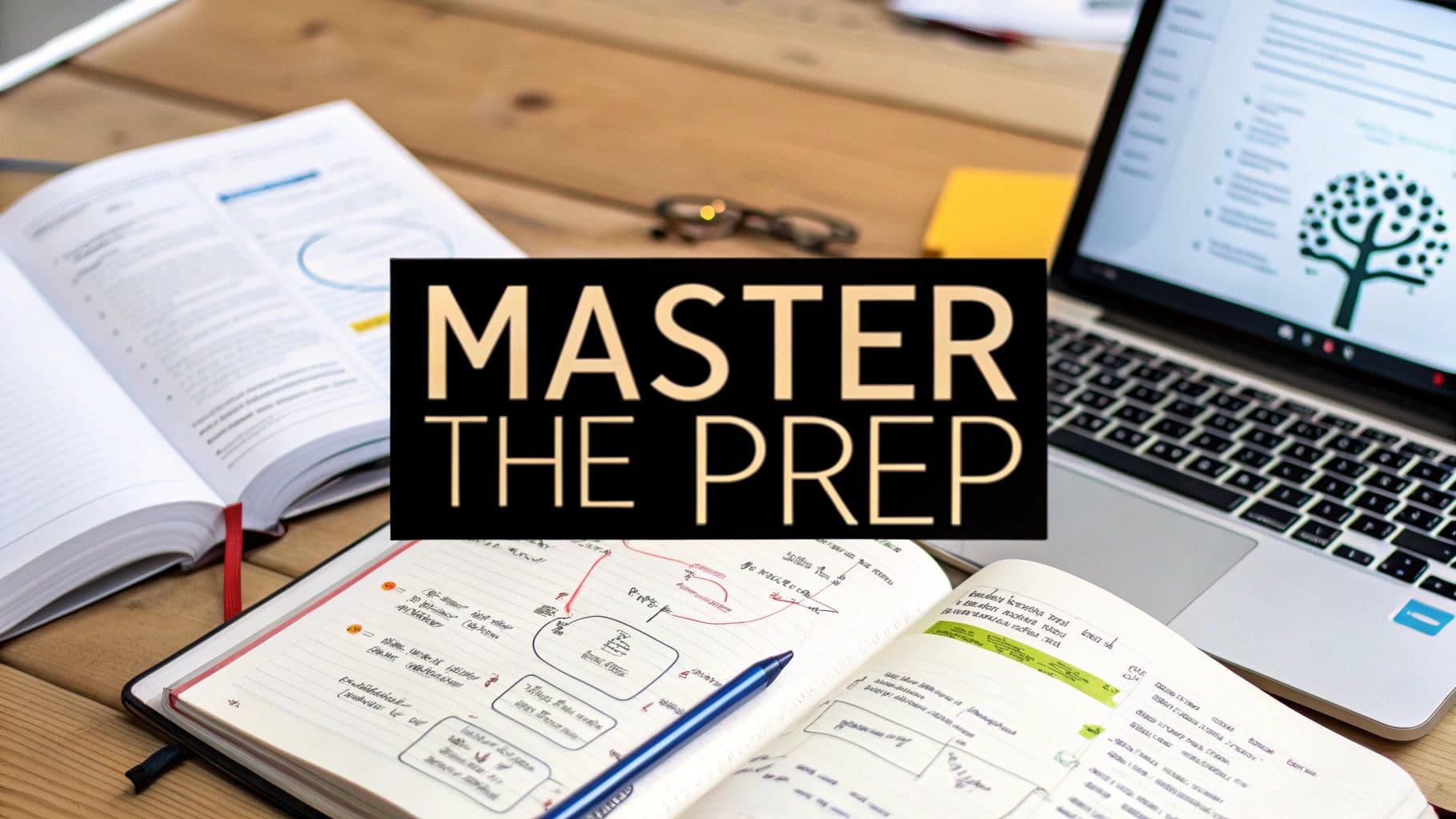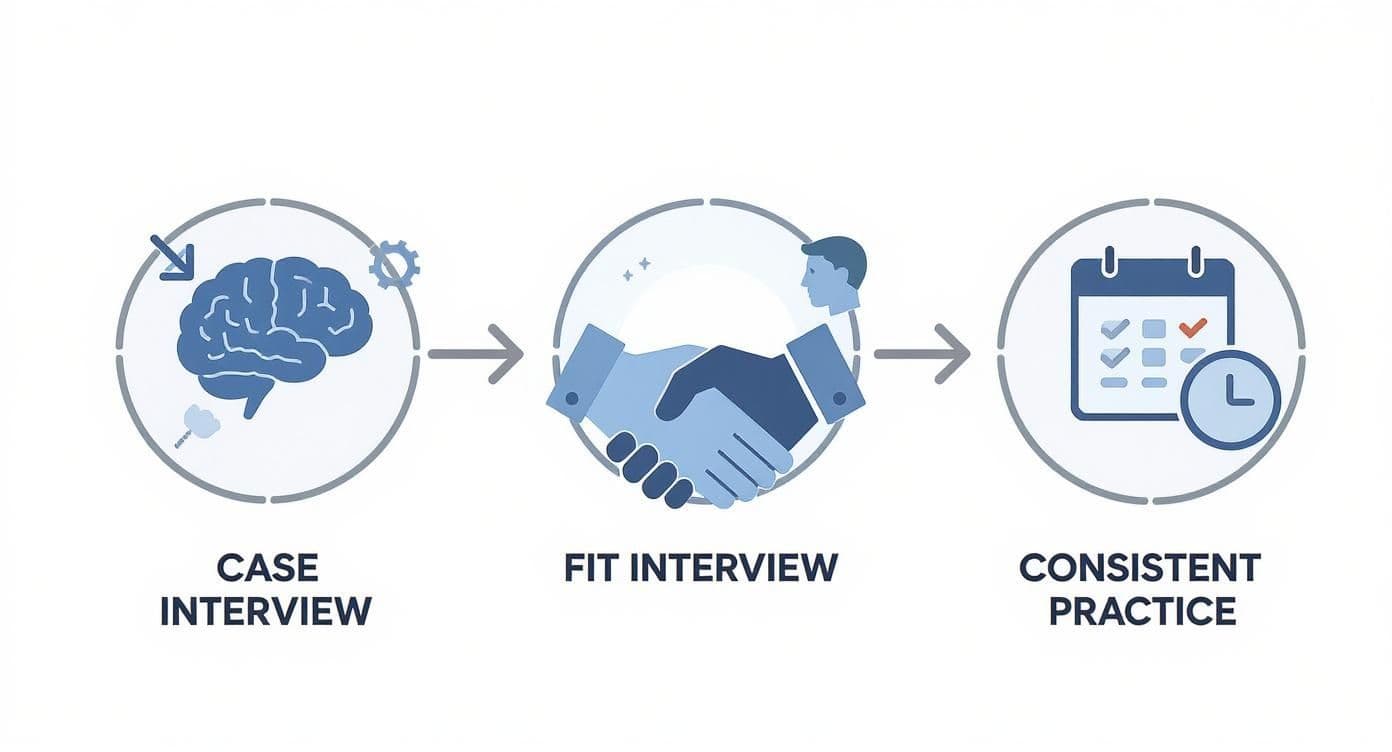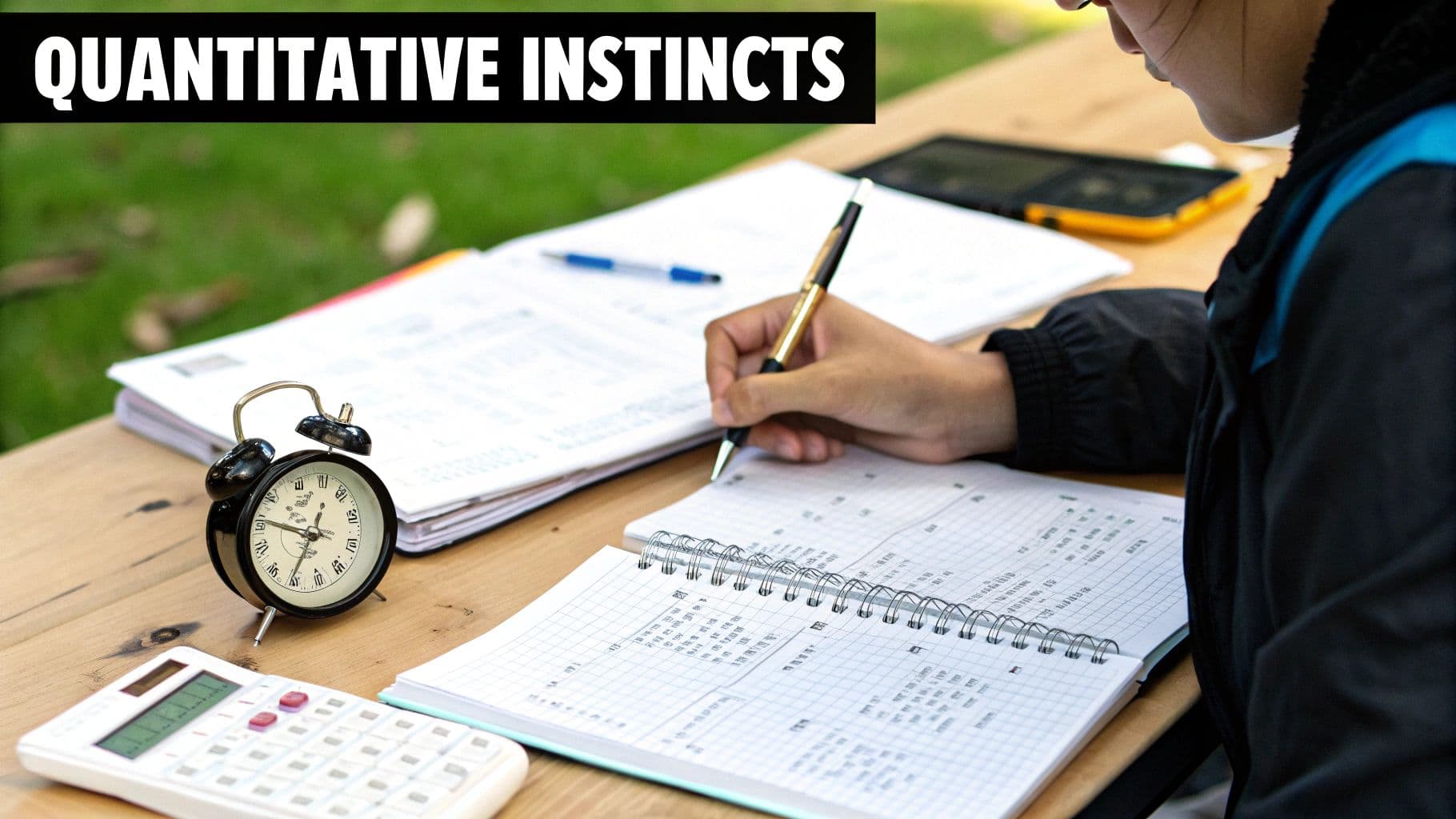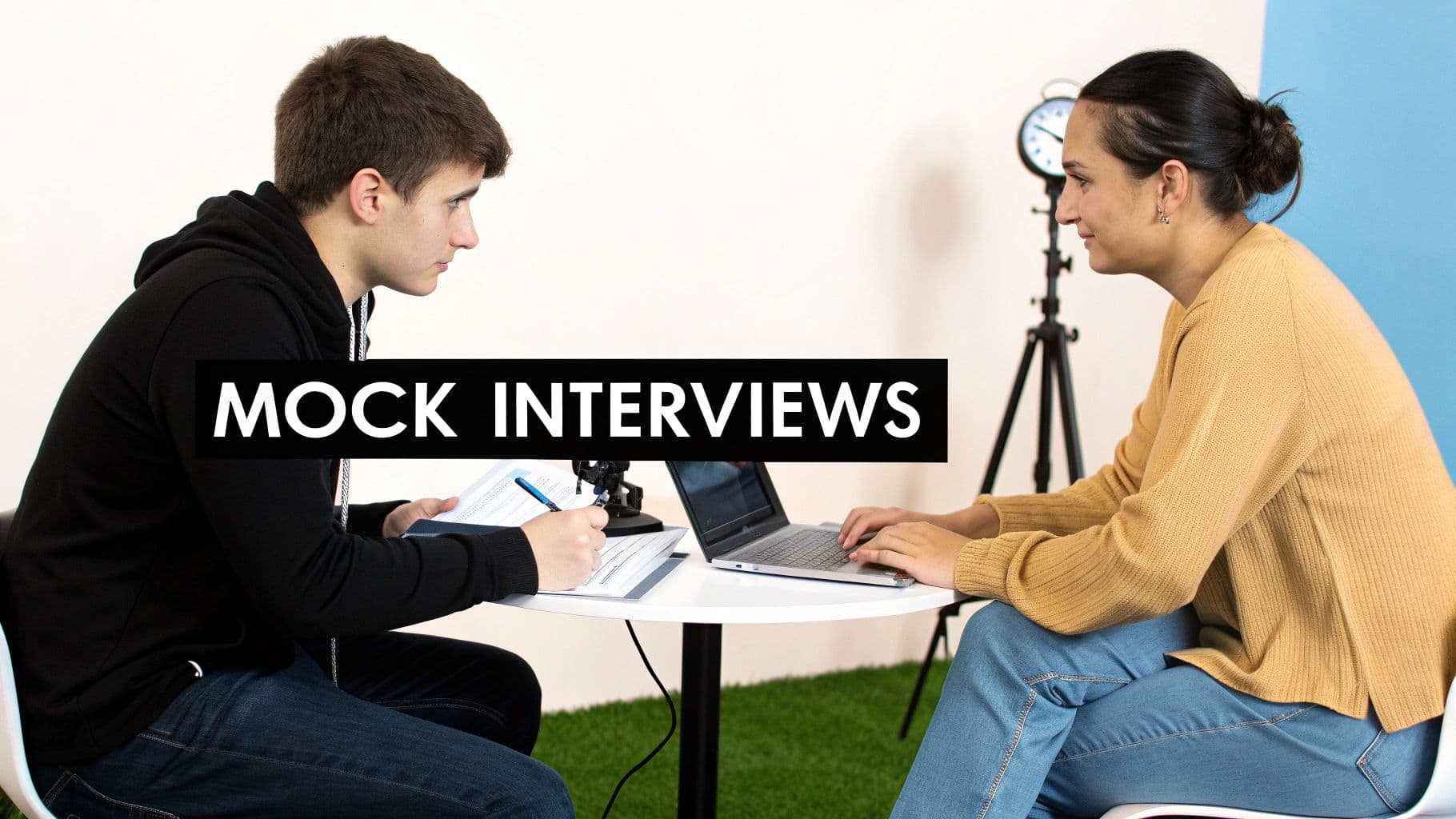how to prepare for consulting interview: Master the prep
how to prepare for consulting interview: Discover case frameworks, behavioral prep, and mock interviews to boost your performance.

Cracking a consulting interview really comes down to two things: acing the analytical case interview and nailing the stories for the behavioral fit interview. Your success hinges on a solid plan that builds muscle memory through practice, keeps your math skills sharp, and hones your ability to communicate clearly.
Your Consulting Interview Preparation Blueprint
Getting ready for a consulting interview can feel like a monumental task, but it’s completely doable if you break it down. Think of this as your roadmap for demystifying the process and building the habits you need to go from overwhelmed to confident.
Top-tier firms like McKinsey, Bain, and BCG have a notoriously tough interview process designed to find candidates who can think structurally and thrive under pressure. Your prep needs to reflect that same dual focus.
To give you a clearer picture, this table breaks down the essential components of a solid preparation plan.
Core Pillars of Consulting Interview Prep
| Pillar | Objective | Focus Activities |
|---|---|---|
| Case Interview Mastery | Develop a structured, repeatable problem-solving method. | Framework learning, market sizing drills, profitability analysis, and full case walkthroughs. |
| Behavioral Fit | Craft compelling stories that show leadership and teamwork. | STAR method practice, resume walkthroughs, and aligning stories to firm values. |
| Consistent Practice | Build confidence and fluency through repetition. | Mock interviews with peers, coaches, or AI tools; solo drills; and constant feedback loops. |
Each pillar supports the others. Strong analytical skills won't get you far without the ability to communicate your value, and great stories are useless if you can't solve the business problem at hand.
The Two Sides of the Consulting Coin
Your entire prep strategy should revolve around these two distinct, yet equally important, areas:
- The Analytical Case Interview: This is where you show off your problem-solving chops. Can you take a vague business problem, break it down logically, run some quick numbers, and pull it all together into a smart recommendation? That's what they're testing.
- The Personal Fit Interview: This is all about seeing if you have what it takes to be a consultant—things like leadership, grit, and the ability to work well with a team and clients. It's where they decide if you're someone they'd actually want on their team for a late-night project.
This infographic lays out the typical workflow for getting ready.

As you can see, both the case and fit prep feed into a continuous cycle of practice. That's the engine that drives improvement.
Why You Can't Just Wing It
Let's be blunt: the competition is fierce. Getting ready for these interviews requires serious, methodical practice because the standards are incredibly high. For example, the pass rate for a McKinsey case interview is well below 10%. That tells you everything you need to know—only the most prepared candidates make it through.
The real goal isn't just to "get the right answer." It's to showcase a structured way of thinking that makes the interviewer trust you. They need to picture you in front of a client, representing their firm with confidence.
To sharpen your skills and find your blind spots, consider working with a coach for interview preparation. That kind of personalized feedback can be a game-changer. Ultimately, this journey is all about building confidence through smart repetition and refinement. For a bigger picture on the industry, our guide on https://soreno.ai/articles/how-to-break-into-consulting offers a broader look at the career path and exactly what firms want to see.
Thinking Beyond Standard Case Frameworks
The case interview is the ultimate test of your consulting potential. It’s where you show you can take a messy, ambiguous business problem, think on your feet, and clearly articulate your thought process. But a lot of candidates stumble here, treating the case like an academic exam where they can just plug a memorized framework into a unique problem.

While standard models like the Profitability Framework or Porter’s Five Forces are good starting points, leaning on them like a script is a classic mistake. Interviewers can spot a cookie-cutter approach from a mile away.
The real goal is to build a custom issue tree that’s tailored to the specific details of the case. This proves you can think from first principles—the very heart of what a consultant does.
From Vague Prompt to Custom Structure
Let's say you get this prompt: "A leading U.S.-based coffee chain is seeing flat revenue growth for the first time in a decade. The CEO wants to know why and what they should do."
A novice might immediately jump in with, "I'd like to use a profitability framework to analyze revenues and costs." That's not wrong, but it's shallow. A much stronger candidate starts by digging deeper with a few clarifying questions.
- Clarifying Questions: "Has this been a sudden drop or a gradual slowdown?" "Is this trend hitting the entire U.S. market or just specific regions?" "Have our main competitors reported similar issues?"
The answers you get here are gold. They shape your entire structure. If the interviewer reveals the slowdown is concentrated in urban West Coast stores, your framework must reflect that. Suddenly, it’s not a generic revenue problem anymore; it's a geographic and demographic problem.
A great framework is not a checklist you run through. It is a logical, MECE (Mutually Exclusive, Collectively Exhaustive) map of your initial hypotheses, designed to guide the conversation and systematically test potential root causes.
Now, your custom structure might have main branches like "Internal Factors (Company-Controlled)" and "External Factors (Market-Driven)," but the sub-bullets will be specifically tailored to the coffee chain's dilemma.
Building Your Issue Tree in Real Time
Once you have that initial clarity, it's time to lay out your structure for the interviewer. Remember, you're not presenting a perfect, finished product. You're thinking out loud and showcasing your logic.
For our coffee chain example, a custom issue tree might start to look like this:
-
Internal Drivers of Stagnation
- Per-Store Performance: Are we seeing fewer customers per store, or are they just spending less per visit? This could point to pricing, product mix, or a declining in-store experience.
- Operational Slips: Have changes in our supply chain or staffing models hit product availability or service quality?
- Brand & Marketing: Is our messaging still connecting? Or has a new competitor stolen the spotlight with our target audience?
-
External Market Pressures
- Shifting Tastes: Are customers drifting toward specialty craft coffee, at-home brewing, or maybe healthier drinks?
- Competitive Heat: Has a new, aggressive player entered key markets with lower prices or a more compelling vibe?
- Macroeconomic Winds: Is a drop in discretionary spending making people think twice about their daily premium coffee?
See how specific that is? It directly tackles the coffee business and builds on the clarifying info you just learned. It gives you a clear road map to start testing your ideas.
You could then kick off the analysis by saying, "My initial hypothesis is that the flat growth is primarily driven by declining per-store performance in urban markets. To test this, I'd first like to understand the trend in average transaction value and customer footfall over the last two years."
This hypothesis-driven approach is exactly what interviewers are looking for. It turns your framework from a static diagram into a dynamic, problem-solving tool. It's a critical skill to master as you prepare for your consulting interview.
Communicating Your Structure with Confidence
How you present your framework is just as important as the framework itself. Don't just list off your buckets. Instead, walk the interviewer through your logic.
Start by quickly summarizing the core problem to make sure you're both on the same page. Then, introduce your high-level structure. Something like, "To get to the bottom of the flat revenue, I'd like to investigate two main areas: factors within the company's control and external market forces that might be impacting their performance."
This simple framing makes your approach easy to follow. As you dive into each branch, you're not just asking for data—you're explaining why you need it and what it will help you prove or disprove. This turns the interview into a collaborative problem-solving session, which is precisely the dynamic you want to create.
Developing Your Quantitative Instincts
In consulting, numbers are the language of business. Your ability to speak that language fluently—to see the story behind the data and make quick, accurate calculations under pressure—isn't just a nice-to-have. It’s a dealbreaker. When you're solid on the quantitative side, you free up precious mental bandwidth to focus on what really matters: generating the strategic insights that will impress your interviewer.
This isn't about memorizing complex formulas or performing statistical wizardry. It’s about building a powerful "quantitative instinct." This means getting comfortable with mental math, making sharp estimations, and using numbers to sanity-check your hypotheses on the fly.
Mastering Consultant-Grade Math
The math you'll encounter in a case interview is very specific. Consultants are constantly working with percentages, growth rates, and massive figures—think millions and billions—all without a calculator. Getting stuck on long division is a classic rookie mistake that kills your momentum and breaks the flow of the conversation.
You need to build speed and confidence in a few key areas:
- Percentage Tricks: To find 15% of a number, don't multiply by 0.15. Find 10%, then halve that to get 5%, and add them together. It’s faster and less error-prone.
- Growth Rate Smarts: Understand the concept behind compound annual growth rate (CAGR) and know how to estimate it quickly.
- Big Number Shortcuts: Get comfortable with dropping zeros and using prefixes. Work with "$2.5B" instead of "$2,500,000,000" to keep your calculations clean and simple.
The real goal here is to make the math feel like second nature. When you're handed a chart with revenue figures, your first thought should be about the implications of the numbers, not the anxiety of having to crunch them.
Strong quantitative skills are a cornerstone of solid case prep. Data from prep platforms shows that shoring up your mental math can prevent silly mistakes and save you critical time. In fact, some analyses suggest that practicing mental arithmetic daily for 3 to 6 weeks can boost a candidate's speed and accuracy by up to 40%. You can learn more about how these exercises are structured and see case interview examples that put them into practice.
Practical Drills for Building Speed
When it comes to math drills, consistency beats intensity every time. A focused 15 minutes a day will do you far more good than a grueling four-hour cram session once a week.
Here's a simple routine to get you started:
- Daily Mental Math: Use an app or just a spreadsheet to drill yourself on multiplication (up to 20x20), percentage changes, and adding/subtracting large numbers.
- Talk It Out: Don't just do the math in your head. Verbalize your steps out loud, exactly as you would in an interview. For instance, "Okay, to find the breakeven point, I'll first calculate the contribution margin per unit. That means subtracting the variable costs from the price..."
- Estimate First, Calculate Second: Before you jump into a precise calculation, make a quick back-of-the-envelope guess. This "gut check" is a great way to catch major errors and demonstrates strong business acumen.
Tackling Market Sizing and Breakeven Analysis
Market sizing questions are a classic test of your ability to apply logical, quantitative reasoning to an ambiguous problem. The interviewer doesn't care if you know the exact answer; they want to see how you build a structured thought process to get there.
Let's say you're asked to estimate the annual revenue of a single Starbucks in a busy downtown area. You wouldn't just pull a number out of thin air. You'd build a logical formula from the ground up:
- (Avg. Customers per Hour) x (Operating Hours per Day) x (Avg. Spend per Customer) x (Operating Days per Year)
From there, you’d make reasonable, clearly stated assumptions for each of those variables. To add a layer of sophistication, you could segment your analysis into peak hours (like the 7-10 AM morning rush) and off-peak hours. This skill is so fundamental that we've created an entire guide on how to approach what is market sizing with clear frameworks.
Breakeven analysis is another common one. You'll need to isolate fixed costs, variable costs, and revenue per unit to find the point where profit hits zero. Mastering these go-to quantitative scenarios gives you a ready-made structure to fall back on when the pressure is on, helping you stay calm, collected, and focused.
While the case interview gets all the glory, the behavioral or "fit" interview is where the firm decides if they actually want to work with you. This is where they find out who you are beyond the resume—your personality, your grit, and your leadership potential. It’s often the ultimate tie-breaker, yet so many candidates pour all their energy into case prep and treat this part as an afterthought. Big mistake.

This isn't about simply walking through your CV. It’s about sharing authentic, powerful stories that prove you have what it takes to be a consultant. In most top firms, the fit interview accounts for roughly 30-40% of your final score. Some data even suggests that candidates who deliberately practice stories around leadership and teamwork see their offer rates jump by as much as 50%.
Go Beyond the STAR Method
You've probably heard of the STAR method (Situation, Task, Action, Result). It's a decent starting point for structuring your thoughts, but if you stick to it too rigidly, you'll sound like every other candidate—robotic and rehearsed. Interviewers have heard hundreds of STAR answers; they can spot them a mile away.
To really connect, you need to turn a simple answer into a compelling narrative. Think of it less like a formula and more like a real story. A great story has a clear beginning, middle, and end. It introduces tension, shows how you were the one to make a difference, and wraps up with a satisfying, measurable conclusion.
Here’s a better way to think about it:
- The Hook (Situation): Set the stage quickly. What was the context? Who was involved? Make it interesting.
- The Conflict (Task): What was the core challenge? What was at stake?
- The Plot (Action): This is the heart of your story. Get into the specifics of what you did. Use "I" statements and own your actions. Don't just say "we improved efficiency"; explain the specific analysis you ran.
- The Resolution (Result): What was the tangible impact? Quantify it whenever possible. Then, cap it off with a quick reflection—what did you learn?
The best stories aren’t always about flawless victories. They’re often about navigating a messy situation, learning from a failure, or showing how you grew. An honest reflection about a tough experience is far more memorable than a perfect, sterile success story.
Build Your "Greatest Hits" Collection
You don’t need twenty different stories. Instead, focus on developing five to seven really strong, versatile ones that you know inside and out. The goal is to build a "greatest hits" collection that you can adapt to almost any behavioral question.
Start by mining your resume for key experiences: internships, leadership roles, challenging group projects, even extracurriculars where you made a real impact. For each one, look for moments that highlight core consulting skills:
- Leadership & Influence: When did you take charge of a project that was going nowhere? Or convince a skeptical team to try your approach?
- Teamwork & Collaboration: Talk about a high-stakes team project. How did you handle a conflict or help a teammate who was falling behind?
- Resilience & Problem-Solving: Tell me about a time everything went wrong. What steps did you take to pull the project back from the brink?
- Failure & Growth: When did you mess up? What did you learn from it, and how did you apply that lesson later on?
Once you have your core stories, practice telling them out loud. Seriously, record yourself on your phone. Does it sound natural? Is the key takeaway crystal clear? This is how you smooth out the rough edges and make sure you sound polished, not programmed. If you need inspiration, check out this list of common consulting behavioral interview questions.
Tailor Your Stories to the Firm's DNA
The final polish is all about customization. Your core story doesn't change, but the angle you take should. You need to frame your experiences in a way that resonates with the specific firm’s culture.
Before you walk into that interview, do your homework. Is the firm known for its entrepreneurial spirit (like Bain)? Or is it famous for its structured, hypothesis-driven approach (like McKinsey)?
Let’s say you have a story about launching a new event for a student organization.
- Pitching to an entrepreneurial firm: You’d highlight how you saw an unmet need, built the business case from scratch, hustled for funding, and drove the project from a simple idea to a sold-out event with minimal hand-holding.
- Pitching to a structured firm: You’d emphasize how you analyzed past event data, formed a clear hypothesis about what would succeed, created a detailed project plan with milestones, and presented a data-backed proposal to get leadership buy-in.
This subtle shift shows you’ve done more than just read their website—you understand what makes them tick. It proves you're not just another qualified applicant; you’re someone who would genuinely thrive on their team.
Building an Effective Mock Interview Regimen
Knowing your frameworks is one thing. Executing them flawlessly when the pressure is on is something else entirely. This is where theory meets reality, and where a solid mock interview plan separates the candidates who get offers from those who don't.
Think of it as your training ground. This is where you build the muscle memory, poise, and quick thinking needed to walk into the real interview with unshakable confidence. Just mindlessly grinding through cases, however, is a recipe for burnout and reinforcing bad habits. Your goal isn't just volume; it's about creating a realistic simulation that gives you sharp, actionable feedback.
Choosing Your Practice Partners Wisely
The people—and tools—you practice with will make or break your prep. A mix of different interviewers is crucial because it exposes you to various styles and helps you spot blind spots you’d never see on your own. Your best bet is to build a roster of peers, seasoned consultants, and even AI-powered platforms.
Each type of partner brings something different to the table. A well-rounded practice schedule knows how to use them all at the right time.
Mock Interview Partner Comparison
To build a truly effective practice schedule, it's helpful to understand the strengths and weaknesses of each potential partner. This table breaks down what you can expect, helping you decide where to focus your time at different stages of your preparation.
| Partner Type | Pros | Cons | Best For |
|---|---|---|---|
| Peers (Other Candidates) | Easy to schedule, highly motivated, and great for building foundational reps. | Feedback quality can be inconsistent; they may not recognize subtle mistakes. | Early-stage practice, volume, and getting comfortable with the case flow. |
| Experienced Consultants | Provide insider feedback, understand firm-specific nuances, and can accurately simulate the real interview pressure. | Can be difficult to schedule and may require payment for coaching sessions. | Mid-to-late stage prep for refining advanced skills and getting a realistic assessment. |
| AI Interview Tools | Available 24/7 for unlimited practice, offers objective data on communication metrics. | Lacks the ability to provide nuanced feedback on strategic thinking or business intuition. | High-frequency drills, improving structure, pacing, and eliminating filler words. |
When you're looking for a peer to practice with, don't just grab the first person who says yes. Find someone who's just as committed as you are and isn't afraid to give you honest, structured feedback. A good partner will push you.
Structuring a Productive Mock Session
A great mock interview is so much more than just running through a case. It's a structured learning experience that should feel just like the real deal, from the moment you say hello.
- Set the Scene: Treat it seriously. Get dressed for an interview, find a quiet spot, and silence all your notifications. You need to replicate the real-world pressure to get the most out of it.
- Define Roles: One person is the interviewer, the other is the candidate. The "interviewer" needs to stay in character, pushing back on flimsy logic and controlling the conversation just like a real partner would.
- Time Everything: Keep it tight. A typical case interview runs 25-30 minutes, followed by 10-15 minutes of no-holds-barred feedback. Using a timer adds a necessary layer of stress that you need to get used to.
Once the case is over, the feedback session is where you strike gold. Don't settle for "That was good." You need to dig in.
The most valuable feedback is specific and actionable. Instead of saying "your structure was confusing," try "When you presented your framework, the second and third buckets overlapped. A better approach would be to separate internal and external factors to make it fully MECE."
Analyzing and Acting on Feedback
Doing the mocks is only half the job. The real growth happens in what you do after the session ends. You have to systematically break down the feedback and turn it into a concrete game plan.
Beyond just conducting mock interviews, the crucial step for improvement lies in a thorough review. Understanding how to analyze interview data effectively is key to spotting patterns in your performance, whether it's consistently missing a certain type of quantitative question or struggling with brainstorming.
Here’s how to make that feedback actually stick:
- Record Your Sessions: With your partner's permission, of course. Watching yourself on video can be a bit cringey, but it’s an incredibly powerful way to catch awkward phrasing, nervous habits, or weaknesses in your body language.
- Keep a Feedback Journal: This doesn't have to be complicated. Just a simple log where you note the case type, the key feedback you got, and one or two things you're going to laser-focus on next time.
- Do Targeted Drills: Did your feedback reveal that your market sizing math is slow? Don't just do another full case. Spend an hour doing 3-4 targeted math drills to isolate and hammer out that specific weakness. This is far more efficient.
This cycle of practice, feedback, and targeted drilling is the single fastest way to build the skills and confidence you need to walk in and ace your consulting interview.
Common Questions on Consulting Interview Prep

As you dive deeper into your prep, you'll inevitably hit some specific roadblocks and questions. Getting clear, practical answers to these final hurdles can be the difference between walking in nervous and walking in with focused confidence. This section is all about tackling those nagging questions that pop up as you're putting the finishing touches on your approach.
Think of this as the fine-tuning phase. Hashing out these details helps clear up any confusion and makes sure all your hard work is pointing in the right direction.
How Long Should I Prepare for a Consulting Interview?
There’s no one-size-fits-all answer, but from what I’ve seen, most people who land offers put in a solid four to eight weeks of consistent prep. And consistent is the magic word here. An hour of focused work every single day for six weeks will beat cramming for an entire week before your interview, hands down.
You’ll want to spread that time across the key areas we’ve discussed. A solid benchmark to shoot for is completing 20 to 30 full mock case interviews. That kind of volume builds the muscle memory you absolutely need to perform when the pressure is on.
What Is the Biggest Mistake Candidates Make?
Without a doubt, it’s applying frameworks like a robot. Interviewers can spot a memorized script a mile away, and it’s an immediate turn-off. The case isn't a test of your ability to recite the "4 Ps"; it's a window into how you think.
The candidates who really shine are the ones who treat the interview like a collaborative problem-solving session with a future colleague. They listen carefully, ask smart questions, and aren't afraid to adjust their structure when new information comes to light. That shows you have real intellectual curiosity and you're coachable—two traits every top consulting firm is looking for.
The goal isn't to present a perfect, pre-baked solution. It's to showcase a logical, flexible thought process that the interviewer can follow and engage with. Your ability to think on your feet is far more impressive than your ability to memorize.
How Do I Handle a Case in an Unfamiliar Industry?
Firms don't expect you to be an expert in something niche like medical devices or specialty chemicals. In fact, they often use these kinds of cases on purpose to see how you handle ambiguity. Your best first move? Acknowledge your unfamiliarity—it shows self-awareness.
Then, just fall back on first principles to break down the business. You can get your bearings quickly by asking smart, foundational questions:
- How does this company make money? (What are the revenue streams?)
- What are its major costs? (What drives the cost structure?)
- Who are the primary customers and what do they value? (Who are we selling to?)
A logical, structured approach in an unknown area is way more impressive than making wild, incorrect guesses. It proves you have a reliable problem-solving engine that can work anywhere.
Should I Use AI Tools for My Interview Prep?
Absolutely, but think of them as a strategic supplement, not a replacement for talking to actual people. AI-powered platforms are incredible for getting in a high volume of practice. They give you instant, data-driven feedback on your pacing, structure, and communication without the headache of coordinating schedules with a partner.
Use AI tools for repetitive drills to sharpen specific skills. But they can’t fully replicate the nuanced, strategic feedback an experienced consultant can give you. The best plan blends both: use AI for volume and nailing the fundamentals, but save your human mocks for high-quality feedback on your overall business sense and executive presence. That balanced approach is a game-changer when figuring out how to prepare for your consulting interview.
Ready to stop scheduling and start practicing? Soreno gives you unlimited, on-demand mock interviews with an MBB-trained AI interviewer. Get instant, rubric-based feedback on structure, numeracy, and communication to pinpoint your weaknesses and accelerate your improvement. Start your free trial at https://soreno.ai and build the confidence to ace your interviews.